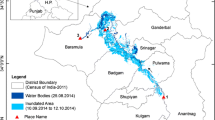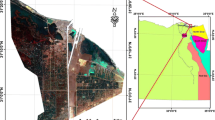Abstract
The Intergovernmental Panel on Climate Change (IPCC) reports an acceleration of the global mean sea-level rise (MSLR) in the twentieth century in response to global climate change. If this acceleration remains constant, then some coastal areas are most likely to be inundated by the year 2100. The ability to identify the differential vulnerability of coastlines to future inundation hazards as result of global climate change is necessary for timely actions to be taken. Yildiz et al. (Journal of Mapping, 17, 1–75, 2003) reported that the local MSLR in the city of Izmir rose at a rate of 6.8 ± 0.9 mm year−1 between 1984 and 2002. In this study, the spatial distribution of the coastal inundation hazards of Izmir region was determined using not only land-use and land-cover (LULC) types derived from the maximum likelihood classification of Landsat-7 Enhanced Thematic Mapper Plus (ETM+) multi-spectral image set but also the classification of the digital elevation model (DEM) acquired by the shuttle radar topography mission (SRTM). Coastal areas with elevations of 2 and 5 m above mean sea-level vulnerable to inundation were found to cover 2.1 and 3.7% of the study region (6,107 km2), respectively. Our findings revealed that Menemen plain along Gediz river, and the settlements of Karsiyaka, Alacati, Aliaga, Candarli and Selcuk are at high risk in order of decreasing vulnerability to permanent and episodic inundation by 2100 under the high MSLR scenarios of 20 to 50 mm year−1.
Similar content being viewed by others
References
Burrough, P. A., & McDonnell, R. A. (1998). Principles of geographic information systems (1st ed.). New York: Oxford University Press.
Brivio, P. A., Colombo, R., Maggi, M., & Tomasoni, R. (2002). Integration of remote sensing data and GIS for accurate mapping of flooded areas. International Journal Remote of Sensing, 23, 429–441.
Church, J. A., & White, N. J. (2006). A 20th century acceleration in global sea-level rise. Geophysical Research Letters, 33, L01602, http://dx.doi.org/10.1029/2005GL024826.
Coppock, J. T. (1995). GIS and natural hazard: An overview from a GIS perspective. In: A.Carrara & F. Guzzetti (Eds.), Geographical information system in assessing natural hazard (pp. 21–34). The Netherlands: Kluwer.
Demirkesen, A. C. (2001). Constructing a prior information-base for river mapping from digital images and DEMs by an advanced image interpretation system. PhD Dissertation, The Ohio State University, Columbus, Ohio, USA.
Eastman, R. (2003). Idrisi Kilimanjaro manual and tutorial. Worchester: Clark Labs, Clark University.
IPCC (2001). Climate Change 2001: Impacts, adaptation, and vulnerability: Contribution of Working Group II to the Third Assessment Report of the Intergovernmental Panel on Climate Change (IPCC) In J. J. McCarthy, O. F. Canziani, N. A. Leary, D. J. Dokken & K. S. White (Eds.). Cambridge, UK: Cambridge University Press.
Jensen, J. R. (1996). Introductory Digital Image Processing: A remote Sensing Perspective (2nd ed.). Englewood Cliffs, New Jersey: Prentice-Hall.
Lillesand, T. M., & Kiefer, R. W. (1994). Remote Sensing and Image Interpretation. New York: Wiley.
Profeiti, G., & MacIntosh, H. (1997). Flood management through Landsat TM and ERS SAR data: A case study. Hydrological Processes, 11, 1397–1408.
Sun, G., Ranson, K. J., Kharuk, V. I., & Kovacs, K. (2003). Validation of surface height from shuttle radar topography mission using shuttle laser altimeter. Remote Sensing of Environment, 88, 401–411.
Wang, Y., Colby, J. D. & Mulcahy, K. A. (2002). An efficient method for mapping flood extent in a coastal flood plain using Landsat TM and DEM data. International Journal of Remote Sensing, 23, 3681–3696.
Yildiz, H., Demir C., Gurdal, M. A., Akabali, O. A., Demirkol, E. O., Ayhan, M. E., et al. (2003). Analysis of sea level and geodetic measurements of Antalya-II, Bodrum-II, Erdek and Mentes tide gauges in the period of 1984–2002. Journal of Mapping, 17, 1–75 (in Turkish).
Author information
Authors and Affiliations
Corresponding author
Rights and permissions
About this article
Cite this article
Demirkesen, A.C., Evrendilek, F., Berberoglu, S. et al. Coastal Flood Risk Analysis Using Landsat-7 ETM+ Imagery and SRTM DEM: A Case Study of Izmir, Turkey. Environ Monit Assess 131, 293–300 (2007). https://doi.org/10.1007/s10661-006-9476-2
Received:
Accepted:
Published:
Issue Date:
DOI: https://doi.org/10.1007/s10661-006-9476-2




